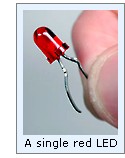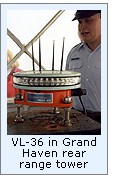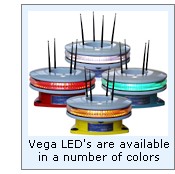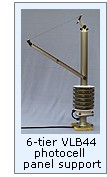 While LED's have been around since the late
1960's, and have been ubiquitously incorporated into displays on alarm
clocks, microwaves and calculators for many years, until relatively
recently the technology only allowed the production of relatively low
brilliance units, and in any color - as long as it was red. As solid state
devices based on semi conductor technology, LED's produce a minimum amount
of heat energy in the process of creating light, and are incredibly energy
efficient to boot. Improvements in LED technology over the past decade
have resulted in the creation of significantly higher light output levels,
along with the production of units LED's which natively output white,
blue, green and yellow light in addition to the standard red. As a result,
LED's are now becoming commonplace in automotive tail light and traffic
signal applications, where they are able to replicate the standard red,
amber and green sequence of intersection control without the addition of
colored lenses which serve to reduce inherent intensity. While LED's have been around since the late
1960's, and have been ubiquitously incorporated into displays on alarm
clocks, microwaves and calculators for many years, until relatively
recently the technology only allowed the production of relatively low
brilliance units, and in any color - as long as it was red. As solid state
devices based on semi conductor technology, LED's produce a minimum amount
of heat energy in the process of creating light, and are incredibly energy
efficient to boot. Improvements in LED technology over the past decade
have resulted in the creation of significantly higher light output levels,
along with the production of units LED's which natively output white,
blue, green and yellow light in addition to the standard red. As a result,
LED's are now becoming commonplace in automotive tail light and traffic
signal applications, where they are able to replicate the standard red,
amber and green sequence of intersection control without the addition of
colored lenses which serve to reduce inherent intensity.
 While virtually all of the maritime
illumination manufacturers now offer LED lighting systems, the Coast Guard
appears to have narrowed its focus on two major manufacturers of LED
lights, conducting extensive field testing of units produced by Vega
Industries and Carmanah Technologies. While Carmanah LED units have been
installed on buoys in a number of locations around the Ninth District, the
Vega VLB-36 LED unit installed in the rear range tower at Grand Haven in
2000 has the distinction of being the only LED unit currently installed in
a major fixed aid to navigation on the Great Lakes. While virtually all of the maritime
illumination manufacturers now offer LED lighting systems, the Coast Guard
appears to have narrowed its focus on two major manufacturers of LED
lights, conducting extensive field testing of units produced by Vega
Industries and Carmanah Technologies. While Carmanah LED units have been
installed on buoys in a number of locations around the Ninth District, the
Vega VLB-36 LED unit installed in the rear range tower at Grand Haven in
2000 has the distinction of being the only LED unit currently installed in
a major fixed aid to navigation on the Great Lakes.
As witness to today's global economic
environment, Vega Industries is located in Porirua, New Zealand,
approximately ten miles north of the capital city of Wellington. The
company was established in 1972, originally offering a line of PEL sector
lights to enable single light range indication at harbor entries. The
company soon branched out into the manufacture of other maritime
illumination systems, and gained international prominence in 1993 when it
shipped its first consignment of VRB-25 rotating beacons to the US Coast
Guard. Since that date, over 200 VRB-25's have been installed in fixed
aids throughout the country, with a few notable examples to be found on
the Great Lakes at Harbor Beach, Outer Island and Oswego West Pierhead.
 Vega currently offers two LED lighting
systems, the VLB-44 and VLB-48, which have largely superceded the VRB-36
installed at Grand Haven. All of these light assemblies are virtually
identical in outward appearance, with their bases and main housings
machined from marine grade aluminum. The LED array, which can be ordered
in white, red, green, blue or yellow, is oriented horizontally around the
circumference of the light module. A precision molded acrylic lens
surrounds the LED's to focus their light into a coherent horizontal band,
affording a tight vertical divergence to ensure that the maximum amount of
light is directed directly in a horizontal plane, and not wasted on the
ground or the sky. Vega currently offers two LED lighting
systems, the VLB-44 and VLB-48, which have largely superceded the VRB-36
installed at Grand Haven. All of these light assemblies are virtually
identical in outward appearance, with their bases and main housings
machined from marine grade aluminum. The LED array, which can be ordered
in white, red, green, blue or yellow, is oriented horizontally around the
circumference of the light module. A precision molded acrylic lens
surrounds the LED's to focus their light into a coherent horizontal band,
affording a tight vertical divergence to ensure that the maximum amount of
light is directed directly in a horizontal plane, and not wasted on the
ground or the sky.
 The VLB-44 features a vertical divergence
of 10º, a peak intensity of 1,535 candelas, and a maximum effective range
of 6 nautical miles, and is designed primarily for use on buoys and minor
aids. The VRB-48 features a narrower vertical divergence of 5º, a peak
intensity of 2,756 candelas, and a maximum effective visible range of 15
nautical miles, making it suitable for installation in larger fixed aids.
These lights also feature a modular design, which allows up to eight LED
modules to be stacked vertically, significantly increasing the overall
intensity and visible range. The VLB-44 features a vertical divergence
of 10º, a peak intensity of 1,535 candelas, and a maximum effective range
of 6 nautical miles, and is designed primarily for use on buoys and minor
aids. The VRB-48 features a narrower vertical divergence of 5º, a peak
intensity of 2,756 candelas, and a maximum effective visible range of 15
nautical miles, making it suitable for installation in larger fixed aids.
These lights also feature a modular design, which allows up to eight LED
modules to be stacked vertically, significantly increasing the overall
intensity and visible range.
 By virtue of an integrated programmable
controller, the lights can also be readily programmed to exhibit a
virtually unlimited range of flash characteristics. Program changes are
entered into a small hand-held controller which contains over 200 built-in
characteristics and memory space to hold 25 additional custom programs.
Once the desired characteristic has been selected, the program can be
beamed directly to the light by way of two-way infra red ports in both the
light and controller. This to-way infra red communication also allows
voltage, light intensity, wattage and other metrics to checked remotely
with the controller without having to open the light to attach test leads
or diagnostic equipment directly to the light itself. As a result, the
modules are factory sealed to provide a reliable 10-year maintenance-free
effective life. Equipped with four plastic "bird spikes" on top
of the uppermost LED module in the stack, feathered interlopers are
discouraged from making a safe landing, further eliminating the need for
frequent cleaning of the acrylic lenses. By virtue of an integrated programmable
controller, the lights can also be readily programmed to exhibit a
virtually unlimited range of flash characteristics. Program changes are
entered into a small hand-held controller which contains over 200 built-in
characteristics and memory space to hold 25 additional custom programs.
Once the desired characteristic has been selected, the program can be
beamed directly to the light by way of two-way infra red ports in both the
light and controller. This to-way infra red communication also allows
voltage, light intensity, wattage and other metrics to checked remotely
with the controller without having to open the light to attach test leads
or diagnostic equipment directly to the light itself. As a result, the
modules are factory sealed to provide a reliable 10-year maintenance-free
effective life. Equipped with four plastic "bird spikes" on top
of the uppermost LED module in the stack, feathered interlopers are
discouraged from making a safe landing, further eliminating the need for
frequent cleaning of the acrylic lenses.
As witness to the reliability and service
free life cycle of these new LED light systems, the VLB-36 installed in
the lantern of the Grand Haven rear range tower three years ago has thus
far required no service, and has performed flawlessly on a daily basis
since its installation by the ATON team from USCG Station Muskegon.
According to mariners the light is readily visible from far across the
water, and serves its purpose extremely well.
Information courtesy
of the Vega Industries catalog
|
 While LED's have been around since the late
1960's, and have been ubiquitously incorporated into displays on alarm
clocks, microwaves and calculators for many years, until relatively
recently the technology only allowed the production of relatively low
brilliance units, and in any color - as long as it was red. As solid state
devices based on semi conductor technology, LED's produce a minimum amount
of heat energy in the process of creating light, and are incredibly energy
efficient to boot. Improvements in LED technology over the past decade
have resulted in the creation of significantly higher light output levels,
along with the production of units LED's which natively output white,
blue, green and yellow light in addition to the standard red. As a result,
LED's are now becoming commonplace in automotive tail light and traffic
signal applications, where they are able to replicate the standard red,
amber and green sequence of intersection control without the addition of
colored lenses which serve to reduce inherent intensity.
While LED's have been around since the late
1960's, and have been ubiquitously incorporated into displays on alarm
clocks, microwaves and calculators for many years, until relatively
recently the technology only allowed the production of relatively low
brilliance units, and in any color - as long as it was red. As solid state
devices based on semi conductor technology, LED's produce a minimum amount
of heat energy in the process of creating light, and are incredibly energy
efficient to boot. Improvements in LED technology over the past decade
have resulted in the creation of significantly higher light output levels,
along with the production of units LED's which natively output white,
blue, green and yellow light in addition to the standard red. As a result,
LED's are now becoming commonplace in automotive tail light and traffic
signal applications, where they are able to replicate the standard red,
amber and green sequence of intersection control without the addition of
colored lenses which serve to reduce inherent intensity.
 While virtually all of the maritime
illumination manufacturers now offer LED lighting systems, the Coast Guard
appears to have narrowed its focus on two major manufacturers of LED
lights, conducting extensive field testing of units produced by Vega
Industries and Carmanah Technologies. While Carmanah LED units have been
installed on buoys in a number of locations around the Ninth District, the
Vega VLB-36 LED unit installed in the rear range tower at Grand Haven in
2000 has the distinction of being the only LED unit currently installed in
a major fixed aid to navigation on the Great Lakes.
While virtually all of the maritime
illumination manufacturers now offer LED lighting systems, the Coast Guard
appears to have narrowed its focus on two major manufacturers of LED
lights, conducting extensive field testing of units produced by Vega
Industries and Carmanah Technologies. While Carmanah LED units have been
installed on buoys in a number of locations around the Ninth District, the
Vega VLB-36 LED unit installed in the rear range tower at Grand Haven in
2000 has the distinction of being the only LED unit currently installed in
a major fixed aid to navigation on the Great Lakes. Vega currently offers two LED lighting
systems, the VLB-44 and VLB-48, which have largely superceded the VRB-36
installed at Grand Haven. All of these light assemblies are virtually
identical in outward appearance, with their bases and main housings
machined from marine grade aluminum. The LED array, which can be ordered
in white, red, green, blue or yellow, is oriented horizontally around the
circumference of the light module. A precision molded acrylic lens
surrounds the LED's to focus their light into a coherent horizontal band,
affording a tight vertical divergence to ensure that the maximum amount of
light is directed directly in a horizontal plane, and not wasted on the
ground or the sky.
Vega currently offers two LED lighting
systems, the VLB-44 and VLB-48, which have largely superceded the VRB-36
installed at Grand Haven. All of these light assemblies are virtually
identical in outward appearance, with their bases and main housings
machined from marine grade aluminum. The LED array, which can be ordered
in white, red, green, blue or yellow, is oriented horizontally around the
circumference of the light module. A precision molded acrylic lens
surrounds the LED's to focus their light into a coherent horizontal band,
affording a tight vertical divergence to ensure that the maximum amount of
light is directed directly in a horizontal plane, and not wasted on the
ground or the sky. The VLB-44 features a vertical divergence
of 10º, a peak intensity of 1,535 candelas, and a maximum effective range
of 6 nautical miles, and is designed primarily for use on buoys and minor
aids. The VRB-48 features a narrower vertical divergence of 5º, a peak
intensity of 2,756 candelas, and a maximum effective visible range of 15
nautical miles, making it suitable for installation in larger fixed aids.
These lights also feature a modular design, which allows up to eight LED
modules to be stacked vertically, significantly increasing the overall
intensity and visible range.
The VLB-44 features a vertical divergence
of 10º, a peak intensity of 1,535 candelas, and a maximum effective range
of 6 nautical miles, and is designed primarily for use on buoys and minor
aids. The VRB-48 features a narrower vertical divergence of 5º, a peak
intensity of 2,756 candelas, and a maximum effective visible range of 15
nautical miles, making it suitable for installation in larger fixed aids.
These lights also feature a modular design, which allows up to eight LED
modules to be stacked vertically, significantly increasing the overall
intensity and visible range. By virtue of an integrated programmable
controller, the lights can also be readily programmed to exhibit a
virtually unlimited range of flash characteristics. Program changes are
entered into a small hand-held controller which contains over 200 built-in
characteristics and memory space to hold 25 additional custom programs.
Once the desired characteristic has been selected, the program can be
beamed directly to the light by way of two-way infra red ports in both the
light and controller. This to-way infra red communication also allows
voltage, light intensity, wattage and other metrics to checked remotely
with the controller without having to open the light to attach test leads
or diagnostic equipment directly to the light itself. As a result, the
modules are factory sealed to provide a reliable 10-year maintenance-free
effective life. Equipped with four plastic "bird spikes" on top
of the uppermost LED module in the stack, feathered interlopers are
discouraged from making a safe landing, further eliminating the need for
frequent cleaning of the acrylic lenses.
By virtue of an integrated programmable
controller, the lights can also be readily programmed to exhibit a
virtually unlimited range of flash characteristics. Program changes are
entered into a small hand-held controller which contains over 200 built-in
characteristics and memory space to hold 25 additional custom programs.
Once the desired characteristic has been selected, the program can be
beamed directly to the light by way of two-way infra red ports in both the
light and controller. This to-way infra red communication also allows
voltage, light intensity, wattage and other metrics to checked remotely
with the controller without having to open the light to attach test leads
or diagnostic equipment directly to the light itself. As a result, the
modules are factory sealed to provide a reliable 10-year maintenance-free
effective life. Equipped with four plastic "bird spikes" on top
of the uppermost LED module in the stack, feathered interlopers are
discouraged from making a safe landing, further eliminating the need for
frequent cleaning of the acrylic lenses.